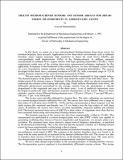Silicon micromachined sensors and sensor arrays for shear-stress measurements in aerodynamic flows
Author(s)
Padmanabhan, Aravind
DownloadFDRL_TR-97-5.pdf (1.634Mb)
Metadata
Show full item recordAbstract
In this thesis we report on a new micromachined floating-element shear-stress sensor for turbulent boundary layer research. Applications in low shear-stress environments such as turbulent boundary layers require extremely high sensitivity to detect the small forces (O(nN)) and correspondingly small displacements (O(A)) of the floating-element. In addition, unsteady measurements in turbulent flows require sensors with high operating bandwidth (~20 kHz). These requirements render most of the existing shear-stress measurement techniques inadequate for this application. In response to the limitations of the existing devices, we have developed a sensor based on a new transduction scheme (optical position sensing by integrated photodiodes). The sensors developed in this thesis have a measured resolution of 0.003 Pa, with a measured range of 133 Pa and the dynamic response of the sensor has been measured to 10 kHz.
The new sensor comprises of a floating-element which is suspended by four support tethers. The element displaces in the plane of the sensor chip under the action of the wall shear stress. The displacement of the element causes a ‘shuttering’ of the photodiodes which are placed symmetrically underneath the element on the leading and trailing edge. Under uniform illumination from above, the differential photocurrent (normalized by the average current) from the photodiodes is directly proportional to the magnitude and sign of the shear stress. A set of analytical expressions were developed to predict the static and dynamic response characteristics of the sensor. Based on these estimates, sensors of two different floating-element sizes - 120 [mu]m x 120 [mu]m x 7 [mu]m and 500 [mu]m x500 [mu]m x 7 [mu]m - were fabricated.
The devices were statically-calibrated in a laminar flow. The static calibration was performed in a custom-designed laminar-calibration flow cell. The sensors have been calibrated over a range of four orders of wall shear stress (0.003 Pa - 10 Pa) and have demonstrated a linear response over the entire regime (the measured non-linearity was 1% (or better) over the four orders of wall shear stress). In addition, the sensors have shown excellent repeatability, long-term stability and minimal drift. The lowest measured shear stress of 0.003 Pa is three orders of magnitude lower than that has been measured before using micromachined floating-element sensors.
The dynamic response of the sensors has also been experimentally verified to 10 kHz. This measurement was performed in a custom-designed plane wave tube (PWT) which was capable of generating oscillating shear stresses of known magnitudes and frequencies, via acoustic plane wave excitation. The measured shear stress showed a square-root of frequency dependence, as predicted by the theoretical relationship. This is the first time that the dynamic response of a floating-element sensor has been experimentally verified using a direct scheme.
The sensors have been tested in both laminar and turbulent boundary layers in the low-speed, low-turbulence wind tunnel at MIT. The response in the laminar boundary layer was found to be linear with the same sensitivity as measured in the laminar-calibration flow cell. The sensor was able to transduce shear stresses of 0.01 Pa and lower, in the laminar boundary layer. The same device also demonstrated a linear response during measurements in a turbulent boundary layer.
We have made design improvements in the second-generation of floating-element sensors. The first-generation sensors employed a two-photodiode differential sensing scheme. This design was sensitive to non-uniformities in the incident illumination. In order to minimize this we have developed a new three-photodiode scheme. The new scheme was designed to null out any linear gradients in the intensity and has demonstrated 94% reduction in sensitivity to intensity variations when compared to the earlier design. The new photodiode design was implemented in the fabrication of one-dimensional arrays of sensors. The sensor arrays have been calibrated in a laminar flow environment. They exhibited a linear response with a measured sensitivity which was in good agreement with the theoretically predicted value.
Date issued
1997-02Publisher
Aerospace Computational Design Laboratory, Dept. of Aeronautics & Astronautics, Massachusetts Institute of Technology
Series/Report no.
ACDL Technical Reports;FDRL TR-97-5